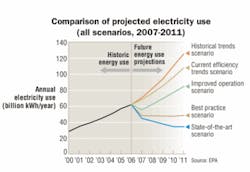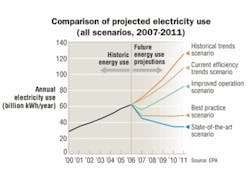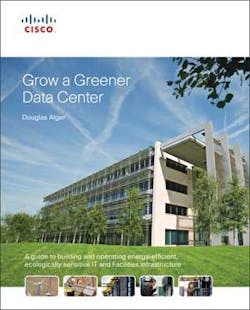EPA establishes Energy Star ratings
The program for servers went into effect in May, while the first Energy Star data centers will be announced in 2010.
In August 2007, the U.S. Environmental Protection Agency (EPA; www.epa.gov) issued a report to Congress on server and data center energy efficiency, in response to Congress’s demand the previous December for the agency to do so. In its report, the EPA estimated that the combination of the nation’s servers and data centers accounted for approximately 61 billion kilowatt hours (kWh), or 1.5% of total U.S. electricity consumption in 2006. The report also detailed energy-efficiency opportunities in servers and data centers, and recommended the investigation of whether to develop Energy Star specifications for these product categories to complement whole-facility energy-saving approaches.
The EPA rather quickly decided in the affirmative, and set about establishing the Energy Star program for computer servers. In February 2008, the agency issued a first draft of the Energy Star specification for servers, and by this May, it had completed its final draft. Throughout the process, the EPA followed its standard procedure of soliciting stakeholder input and feedback as four drafts were developed before the final draft was issued.
Server specification finalized
In a memo to stakeholders dated May 15, the EPA stated it “has commenced efforts to develop the next tier of this computer server specification to ensure that the specification continues to identify the most energy-efficient products in the marketplace. During the Tier 2 process, EPA plans to: review all specification elements and criteria for refinements; expand the scope to include, but not limited to, servers with greater than four processor sockets, blade systems, fully fault tolerant servers, server appliances, multi-node systems; and evaluate the potential benefits of an et power loss approach. In addition, EPA is exploring an approach to efficiency that reconciles the energy consumed by the system and the work being performed...EPA’s goal is to finish Tier 2 in time to take effect by October 15, 2010.”
EPA spokeswoman Enesta Jones tells Cabling Installation & Maintenance, “Servers that earn the Energy Star will be, on average, 30% more energy efficient than conventional models. If all servers sold in the U.S. meet this new specification, energy cost savings would grow to $800 million per year and prevent greenhouse-gas emissions equivalent to those from over one million vehicles. EPA anticipates that qualifying product will be available through office equipment manufacturers and value-added resellers in the near future.”
Jones further states that servers earning the Energy Star rating will include:
- Efficient power supplies that have smaller conversion losses and generate less waste heat, reducing the need for excess air conditioning in the facilities where they are housed;
- Improved power quality, which provides building-wide efficiency benefits;
- Capabilities to measure real-time power use, processor utilization, and air temperature, which improves manageability and lowers total cost of ownership;
- Advanced power management features and efficient components to save energy across various operating states, including idle;
- A power and performance data sheet (PPDS) for purchasers that standardizes key information on energy performance, features, and other capabilities.
“The PPDS is a key requirement in the server specification,” Jones says. “EPA felt strongly that more energy information transparency is needed for IT professionals trying to estimate TCO. The PPDS is a standardized information resume that is required to accompany each Energy Star server configuration or family. A product cannot be marketed as Energy Star without one.”
She adds that each PPDS “is about two pages long, with detailed information on various aspects of its energy performance. This information will help level the playing field so that server manufacturers make consistent claims that can be compared to one another by IT purchasers.”
Jones concludes, “Lastly, the PPDS must be placed in a specific location on each manufacturer Web site to ease the search for product-performance information. EPA hopes that, over time, industry will publish a PPDS for every server, even those that are not Energy Star.”
Douglas Alger, IT architect for physical infrastructure with Cisco Systems (www.cisco.com), says, “This is a first-generation standard, and is a big step forward from where we were before.” As manager of several of Cisco’s data centers, Alger authored the book Build the Best Data Center Facility for Your Business, which was published four years ago. He recently completed work on a new book, Grow a Greener Data Center, which is due out this month.
“Some people knock the current [Energy Star for computer servers] system because it does not incorporate blades or virtualization, and the pool being covered by the current system is fairly small,” Alger notes. “But I wouldn’t knock it for that. It is a good first step.”
This first-generation Energy Star specification applies to hardware with up to four sockets, Alger explains. “Coming in 2010, there will be a second tier applying to hardware that includes blades,” he says.
He recalls the year-plus process in which Enery Star drafts were created, and comments shared by interested parties: “Some early drafts were going to include blades, then later drafts did not include blades.” A lot of what ultimately ended up in the EPA’s final version of the specification, Alger says, was “shaped by input they have gotten.”
At the same time, he acknowledges that not every decision is made with energy efficiency as a top criterion. “You can’t necessarily say if it’s got the sticker on it, it’s what I need,” he asserts. Because purchase decisions are made in real-life enterprise environments and not in an idealistic vacuum, sometimes users do the best they can with what they have. “It gets into purchasing decisions for hardware,” Alger notes. “Sometimes, a purchase is made because an IT budget is about to expire. The IT manager has to achieve a certain number of tasks, and may buy a server that can do the most processing, while at the same time making sure to spend their budget before it goes away.”
Facilities spec in the works
As the Energy Star specifications for computer servers evolves into a second phase, the EPA is ramping up the program through which it will grant the Energy Star rating to data center facilities.
The EPA’s Jones says, “The EPA has identified the data center information technology sector as a promising area for energy-efficiency opportunities in the U.S. and abroad. While data centers are critical infrastructure and support every sector of the economy, their energy consumption is growing rapidly. Data centers will account for nearly 3% of total U.S. electricity consumption by 2011, and their associated carbon-dioxide emissions will eventually rival those from the airline industry.”
Jones adds, “Information technology also has the unique potential to enable more efficiency throughout the economy by helping to displace energy-hungry processes. Data centers will play a vital role to provide the computing backbone to deliver these new services that will help lessen the dependence on carbon-intensive processes. EPA is developing an Energy Star facility benchmark for entire data centers; EPA hopes to publish the new benchmark early next year. This tool will provide a 0-100 scale to assess efficiency that can be used to compare the relative efficiency of different facilities.”
Jones says that the agency views the new server program and the forthcoming data center program as complementary and essential tools for any organization developing a strategic data center energy-management plan.
Cisco’s Alger notes that several of his company’s data centers were among the facilities from which the EPA gathered data while developing its specification. “They have done an honest and thorough job wanting to get information from data centers,” he comments. “They have asked, ‘What is practical for us to set as benchmarks and goals for companies to achieve?’ From that perspective, they want to set guidelines based on what is realistic,” in terms of what can be measured on the facilities side of the equation and the IT side.
Energy consumption and IT
The 0-100 scale of energy efficiency may lean heavily on a facility’s power consumption and less so on IT infrastructure management techniques. The collection form that prospective Energy Star facilities must submit to the EPA requests information about the consumption of energy, including electri-city, natural gas, and other sources. Among that information is a section labeled “IT Measurement,” which asks for total IT plug energy from UPS meter in kWh as well as total IT plug energy from PDU meter in kWh (if the latter information is available).
Separately, the collection form requests information that it labels “optional elements,” to be used for future study. Among the optional elements is whether the facility employs liquid cooling for IT equipment and/or racks. It also asks applicants to indicate which of the following air-management techniques they employ:
- Blanking plates in racks;
Hot-aisle/cold-aisle arrangement;
Computational fluid dynamics modeling;
High-delta “T” cooling;
Air-separation chambers;
Racks with air-management control;
Static pressure control;
Static pressure boundaries;
Dynamically managed airflow.
Alger echoes the EPA’s statement that the server and data center specifications are complementary efforts, and data center managers would do well to consider a holistic approach to energy efficiency. Specifically, he discusses the reality of decision-making with respect to server purchases. IT managers work within budgets, and within budget calendars, he explains: “Often, they buy the server that can do the most processing, and make sure to spend money before it goes away” at the end of a budget cycle. That doesn’t always translate to purchasing the most energy-efficient products, and often prohibits an IT manager from waiting for more-energy-efficient products to reach the market.
Plus, in many situations, the IT manager purchasing the hardware does not see the electric bill that lands on the desk of the facilities manager. “It is challenging to get those two to sync up,” in many organizations, Alger notes. “There is a big cost on the back end in terms of electrical resources, the power bill that must be paid, et cetera.”
Currently, a majority of facilities do not have submetering, which would allow more transparency into the IT function’s power consumption. “But it’s very common to have it employed where facilities are being constructed,” Alger says. “Just as a majority of data centers are in mixed-use buildings, submetering is probably the exception rather than the rule. But it’s where things are going. We’re seeing it in larger, dedicated data centers.”
The role of the storage area network (SAN) is not lost on the EPA either. In late April, the agency announced it intends to continue development of an Energy Star specification for enterprise data-storage equipment. Energy Star program manager Andrew Fanara told stakeholders in a memo the agency “recently conducted a scoping effort to evaluate enterprise storage products for inclusion in the Energy Star program. EPA reviewed available market research and facilitated discussions with product manufacturers, industry associations, and other interested parties. EPA concluded that IT purchasers would benefit from access to standardized information about the energy performance of storage equipment made available through the Energy Star program. As a result, EPA intends to begin the specification development process.”
Energy efficiency in focus
The EPA’s Jones told CI&M, “The first enterprise-level specification for servers has been completed, and research for data storage and networking equipment is underway.” Before very long, data centers may have the opportunity to deploy Energy Star rated servers including blades, storage devices, and network devices. And those facilities themselves may carry the Energy Star rating. To be certain, energy efficiency in data center environments is very much in focus for the United States Environmental Protection Agency.
MATT VINCENT is senior editor of Cabling Installation & Maintenance.
Book on green data centers includes chapter on cabling
The book Grow a Greener Data Center by Cisco Systems’ Douglas Alger is due to be available in mid-August, just about the time this issue reaches you. In a phone conversation with Alger, he stated, “Four years ago, I wrote Build the Best Data Center for Your Business. After talking to users and attending industry conferences, I heard a lot of discussion around what are best practices. That book was an attempt to build a data center that was robust, scalable, flexible, and modular, whether you were building new or retrofitting. It was based on the questions I was hearing then.”
The new book takes a different tack. “As of a couple years ago, ‘green’ has become a much more vital topic,” the author told us. “Sometimes, that’s because people want to do the right thing and help the environment. Other times, they want to be energy efficient. Others want to optimize the lifespan of existing facilities. ... The book is about how to optimize your resources.”
Grow a Greener Data Center’s theme came out of customer engagement, as did Alger’s first book. He summarizes its contents: “Frankly, I wrote the book I wanted to have on my own bookshelf.”
One chapter of the book deals with cabling issues, “which get almost no attention when people think ‘green,’” Alger says. “It was interesting to get involved in that aspect and find out how choices can influence airflow and power consumption. Farther upstream, it looks at what types of resources have to be devoted to extracting glass versus obtaining copper.” –M.V.
More Cable Installation & Maintenance Issue Articles


